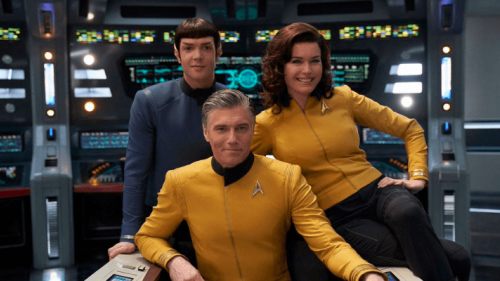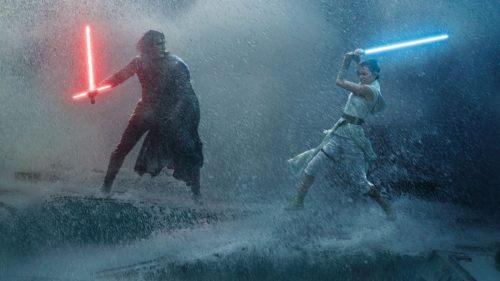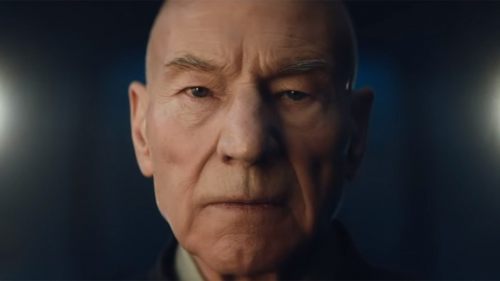ScoreKeeper Boldly Goes to Houston for STAR TREK Live
Last month I attended the U.S. premieres of Michael Giacchino’s scores from Star Trek (2009) and Star Trek Into Darkness (2012) in Houston, Texas. Every note, from the opening frame to the last, was performed live to picture inside Jones Hall which boasts a maximum capacity of around 2,900 seats. While I don’t believe that either concert was officially sold-out, it appeared after scanning the mammoth auditorium that very few seats were available. The silver screen was sufficiently large as it hung lurking behind the hundred and forty musicians which make up the Houston Symphony and the Houston Symphony Chorus.
Giacchino himself was in attendance for both concerts. Before the start of each film, he walked out on stage to thunderous applause and introduced each movie. Always humble and relaxed, Michael expressed what an honor it was for him to premiere these two scores in the city which NASA and manned spaceflight calls home. He even acknowledged a dear friend of his sitting in the audience who worked at NASA.
As the orchestra members tuned and the conductor made his way to the podium, I wasn’t completely sure what to expect. I’ve attended film music concerts that were performed live to picture on plenty of occasions (even composed a few scores myself); however, I’ve never experienced a live film score presentation that wasn’t from the silent era of cinema. How would a modern movie with dialogue and sound effects stand up against a live concert performance? I wouldn’t have to wait long to find out.
As the hall darkened and the film began to roll, the conductor raised his arms in anticipation of the opening downbeat. With a gentle lift and fall of his arms, the sumptuous sound of the French horn filled the chamber with Giacchino’s heroic main theme as the familiar Bad Robot raced across the screen. I was already getting goosebumps.
By the time the first cut to the USS Kelvin filled the screen, I was already lost inside a state of deep emotional bliss. I’ve experienced this film a handful of times but to see and hear the Houston Symphony and Houston Symphony Chorus on stage performing this amazing score in real time was a mind-blowing experience.
The film had all the dialogue and sound effects intact as the conductor, Constantine Kitsopoulos, led the orchestra through the picture frame by frame in perfect sync. There were subtitles for the dialogue throughout the entirety of the movie. At first I found this mildly annoying but I quickly became reliant upon them as the music often exceeded the levels of the dialogue.
If there was any lingering doubt about how special this experience was going to be, it was quickly assuaged within the first few minutes. One of my all-time favorite Giacchino scored scenes occurs early in Star Trek when Papa Kirk flies the USS Kelvin into the Narada. It’s such a powerfully emotional scene as most of the sound effects and all of the dialogue are stripped away in order to allow the music to carry the emotional weight unobstructed. As the accompanying music swelled and lifted from the stage, I’m not embarrassed to admit that I got a bit teary-eyed. After that, I was settled in for what I knew was going to be an amazing ride.
In order to give the conductor and the orchestra (and the audience for that matter) a brief breather, there was an intermission about halfway through the film. As I sat there waiting patiently for the start of the second half, I heard a voice call my name a few rows back. I turned around. It was Michael! He asked me if I would be willing to come up on stage after the performance and moderate a brief Q&A. He had a few tweeted questions written down on a piece of paper and exclaimed how awkward it would be if he just stood up there reading them. I completely agreed and instantly volunteered for the task. Although I was excited (and perhaps a bit nervous) about the prospect of leading an impromptu Q&A in front of all those people after the concert, I immediately nestled into my seat and shifted my focus to the second half of the concert.
When the concert was over, I made my way backstage and before too long, found myself standing in front of the audience introducing our featured guests for the evening. Giacchino and Kitsopulos sauntered out on stage and sat down next to me. I asked a handful of questions before turning it over to the audience. The three of us chatted and jawed for about 45 minutes to the delight of each audience member. Michael and Constantine talked about everything from the technical challenges of putting together a live music-to-picture concert to offering advice for young composers.
It was during the Q&A when Kitsopulos revealed that the click track he relies upon in order to keep the entire orchestra in sync with the picture failed within the first minute of the film. Unable to get it working again, he was forced to conduct the entire first half of the concert without click using only the conducting aides overlaid on his personal monitor. Not an easy feat for any seasoned conductor! I’ve conducted to picture plenty of times in my lifetime but never on stage in front of 2500 people. The enveloping sense of panic invading Kitsopulos’ psyche should’ve been paralyzing. As it turned out, nobody in the audience ever knew about the glitch as the performance went on without a hitch.
One of the questions I was eager to ask Michael, was about my favorite scene at the beginning of the film where the Kelvin and Narada collide. Giacchino admitted that he was originally going to score it as “an action scene”; however, each time he looked at it, he felt sadness. The decision to remove the sound effects and dialogue occurred on the dubbing stage in response to Giacchino’s impactful music for that scene.
During the Q&A, Michael also revealed his desire to produce more of these concerts in the near future and cited Ratatouille (2007) and Up (2009) as the next two possible contenders. (Yes please!)
After the Q&A the line of folks swarming the stage to seek Michael’s autograph was intimidating. I stood there goggling as he signed each and every item handed to him. He only paused to snap photos and chat amongst his fans. When it was finally time to exit the stage, he slipped out the rear stage door onto Texas Street and signed more autographs for folks waiting patiently for him there. Giacchino was extremely gracious with his time and I even overheard him telling a Houston Symphony employee that he would hang around as long as he needed so that everybody who wanted to meet him would have the opportunity.
Since our Q&A went over so well the first night, Michael asked if I would resume my role as moderator the next evening after the performance of Star Trek Into Darkness. I think I said yes before he finished the question.
The following night was just as spectacular and impressive as the first night. In some ways, I actually admire Giacchino’s music for Into Darkness a smidgeon more than the first film. Like a classical symphonic sonata form, Into Darkness is reminiscent of the “development” section of the largely expositional Star Trek. This combination of familiar themes developed along side new material is the crux of a successful sequel score.
The overall sound quality the second night was even better than the first. The Houston Symphony Chorus was difficult to hear during the Star Trek performance, but this was remedied in time for Into Darkness. The mammoth ensemble (perhaps more confident with one performance under their belt) performed with a bit more gusto and vigor than the previous evening. There was another intermission about half-way through and Michael and Constantine held another Q&A (moderated by yours truly) after the performance. When we concluded our time on stage, Michael signed autographs on stage, in the green room, and then again just outside the backstage door exiting to the street. He was there until the last fan shook his hand and headed home.
As a die-hard fan and dutiful champion of film music, the significance of these evenings was not lost on me. Although concerts like this are not necessarily new, I wouldn’t go so far to say that it’s a common occurrence. I’ve attended recording sessions in some of the great studios in Hollywood where über-talented musicians perform scores to picture every day. The common fan doesn’t ever get to witness this unique brand of cinemagic. These concerts not only let film music fans and cinephiles enjoy their favorite scores performed by exceptional ensembles, but it also allows each pair of eyes and ears a glimpse into the world responsible for weaving the emotional tapestries of the films they adore. When we witness a hundred talented musicians performing together in perfect harmony to create this work art, it transfers the aesthetic value from its non-visual characteristics and humanizes its creation.
I’ve always felt that my role in this world as a champion of film music is to help demystify a very mysterious craft. I loved the performances themselves; however, when I look back guffawed at the 2500 people seated in Jones Hall, I realize how powerful these concerts are in elevating the craft I love so dearly. Film music is a niche interest which piggy-backs on the general popularity of cinema; however, that’s not what these concerts were about. Why would somebody spend $65-125 to see a movie they probably own on DVD or Blu-ray at home? No, this was a new way to celebrate music! It’s not a cinematic experience and it’s not purely a concert experience either but rather a marriage of the two combined to form something quite unique.
After selling-out performances throughout Europe and North America, Giacchino and others are on the verge of exploding an entire new world of performance potential using live music-to-picture concert experiences. Star Trek and Star Trek Into Darkness will continue to travel around the world including stops in San Antonio, Texas, Toronto, Canada, and Melbourne, Australia to name a few.
I strongly encourage more live music-to-picture concerts.



